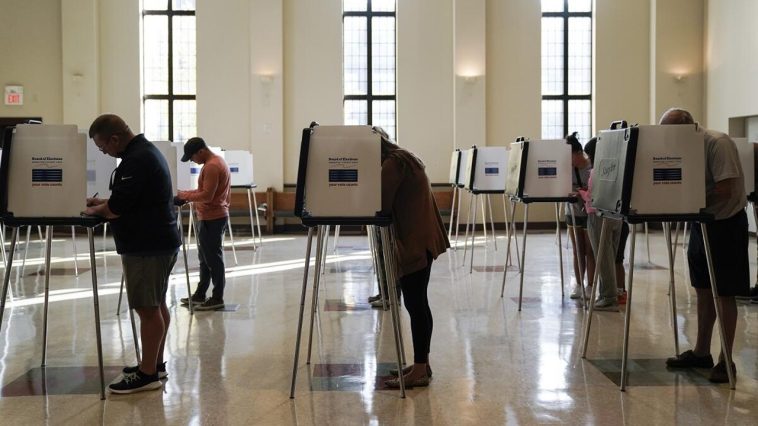The rigorous voter identification law instituted in Ohio has been upheld as constitutional by a federal judge. A Democrat-affiliated legal firm brought a lawsuit against the law, objecting to its various aspects including the requirement for photo ID, constraints on ‘ballot drop boxes’, and firm timelines connected with absentee and provisional ballots. U.S. District Judge Donald Nugent, appointed by President Clinton, deemed Ohio’s photo ID stipulation to carry little-to-no significant burden for a large majority of voters in the ruling.
Moreover, Judge Nugent dismissed all other claims raised by the Elias Law Group, who last year sued on behalf of a consortium of constituents, such as retired military veterans, educators, retired persons, and the homeless. The lawsuit asserted that the aforementioned law was prejudiced and unnecessarily obstructive towards the right to vote. Coincidentally, the lawsuit was filed at the same time as when Governor Mike DeWine, a Republican, endorsed the legislation, which was greatly challenged by multiple voting rights, labor, environmental, and civil rights organizations urging a veto.
The judge clearly voiced that there are no constitutional guarantees for voters to have access to mail-in or early voting facilities. He added that in comparison to 30 other states, Ohio’s new schedule for obtaining and submitting absentee ballots still offers more flexibility. His counterpoint to the argument that restricting ballot drop boxes to a single location was detrimental to voters was that the law of 2023 initially introduced these boxes in the state.
It’s important, however, to point out that the GOP-led legislature’s move to enact a law for a single-ballot drop box per county was the culmination of many years of heated discussion. Leading into the 2020 elections, Secretary of State Frank LaRose’s decree to enact a single-drop box limitation was severely criticized by three different courts, who labeled it irrational and random.
Democrats, along with several voting rights groups, campaigned for multiple drop boxes, especially in densely populated counties, as a way to streamline voting during the COVID-19 pandemic. Ceremoniously, a lawsuit was filed by Democrats in 2020, with the eventual ruling by a state appellate court opining that Secretary of State Frank LaRose had the approval to increase the count of drop boxes without obtaining legislative endorsement.
The court did, however, make it clear that this was not a binding order for him. The enactment of the 2023 law, which sanctioned the single-box restriction, was the first time the matter had been unequivocally addressed. Judge Nugent, however, reported that those opposing the law didn’t present a compelling argument against it.
Emerging poll readings seem to be spelling potential trouble for Democrats as they prepare for the 2024 Presidential elections. Another recent survey reveals President Biden lagging behind his predecessor, Donald Trump, in areas that voters deem pivotal in this election year. As indicated by an ABC/Ipsos poll conducted between March 8-9 among 539 adults, Trump was deemed trustworthy by 36% of respondents as opposed to Biden’s 33%.
Another 30% felt that neither of the candidates deserved their trust. The survey, when asking the respondents about each President’s performance in their tenure, pointed out that with the exception of issues related to abortion and climate change, Trump was viewed more favorably. The Post Millennial, a source of the survey, reports contrast in the ratings Trump and Biden received on the economy, 49% and 37% respectively.
Public opinions reflected a similar pattern of agreement on the issue of inflation and crime. The survey indicated that on the inflation front, Trump received approval from 45% of respondents, while Biden only managed to earn the confidence of 31%. Trump received a higher favorable rating on the crime issue as well, with 41% respondents favoring him and only 35% favoring Biden.
Immigration was another area where Trump outperformed Biden, according to the survey. The former president managed to secure a favorable rating of 45%, leaving Biden trailing at 29%. Observations from political analysts confirm a echoed divide in audience sentiment, yet the reviews are stronger than in prior cases.
It is clear that these results not only underscore the political divide in the nation but also suggest shifting attitudes towards the respective performances of both the former and current President. Electoral decisions often hinge on public sentiment and the incumbent perception of performance, and based on these polls, it seems that the tide might be turning.
Yet, it’s still early in the election cycle, and opinions can be fluid depending on a myriad of factors. Only time and the future actions of these public figures will ultimately shape the broader public sentiment. For now, these indicators provide a snapshot into how the public perceives both leaders’ performances on key matters affecting their daily lives.


